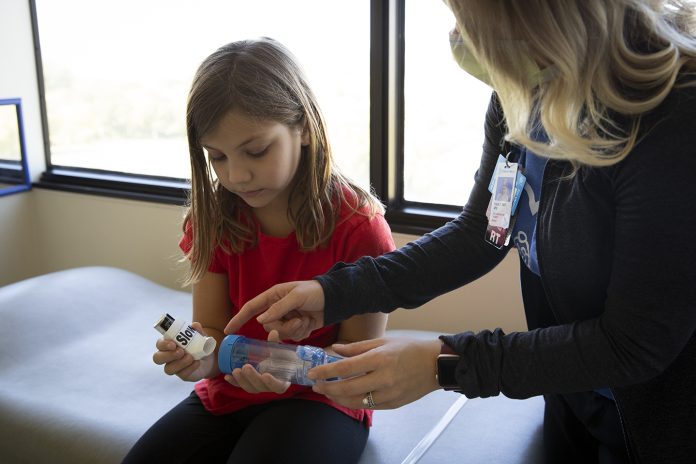This post is sponsored by Children’s Mercy, and written by
Jade Tam-Williams, MD, Children’s Mercy Pediatric Pulmonologist.
The holidays are a wonderful time of year, but it can also be a tricky time of year for kids with asthma. Cold weather and other considerations, like real Christmas trees or strong holiday fragrances indoors can worsen asthma symptoms. It’s important to keep in mind possible triggers to help ensure everyone stays healthy! Having the right care plan and medication in place will help keep asthma symptoms in check so kids and teens can enjoy seasonal activities. Whether you have someone in your life that has already been diagnosed with asthma, here are some answers to come common questions about asthma.
What causes asthma?
Asthma is somewhat a mystery when it comes to what causes it, but we do know it can be a mix of genetics and environmental causes. We know that if someone in your family has asthma, you are more likely to have asthma yourself. Environmental factors that affect asthma could be poor air quality, tobacco or vaping smoke exposure, chemicals, fumes or pollution.
Who can get asthma?
We know 1 in 2 kids will wheeze at least once in their lifetime. Wheezing is caused by a viral infection, but not all kids who wheeze will go on to develop asthma. You can develop asthma at any time. Typically, when we see asthma in kids, we see it in two groups. The first is preschool asthma — kids who have asthma symptoms before the age of 6. The other is persistent asthma — kids who have asthma symptoms beyond the age of 6.
How does it affect breathing?
In asthma, air doesn’t move through the lungs the way it should. Normally, when someone breathes in, air goes in through the nose or mouth, down the windpipe (trachea) and into the airways (bronchioles) of the lungs. When people breathe out, air exits the body in the opposite direction.
With asthma, air has a harder time passing through the lungs. Airways swell and fill with mucus. The muscles around the airways tighten, making airways narrower. Things that can irritate the airways of someone with asthma are sometimes called “triggers.”
What are the symptoms?
The onset of asthma symptoms is often referred to as an asthma flare-up or an asthma exacerbation. They happen when airways get more irritated and inflamed (swollen) than usual.
During a flare-up, kids might have:
- trouble breathing
- a tight chest
- a whistling sound while breathing (wheezing)
- a cough
- a fast heartbeat
Some flare-ups are serious, but others are mild. Flare-ups can happen suddenly or build up over time, especially if kids don’t take their asthma medicines as directed.
How is asthma diagnosed in children?
Asthma is diagnosed by a doctor. The doctor will ask about your child’s symptoms, medical history, family history and do a physical examination. Tests like blowing into a spirometer also known as lung function testing can measure airflow may be helpful. Chest X-rays may also be helpful.
What are asthma triggers?
One way to help manage your child’s asthma is to avoid asthma triggers. Some triggers seem harmless to most people but can cause serious flare-ups in kids with asthma.
Triggers vary from person to person, but common ones include:
- Cigarette or vaping smoke.
- Air pollution like car exhaust fumes and smog.
- Dust, pollen and mold.
- Pet dander from things like cat hair and dog saliva.
- Exercise.
- Weather changes.
- Dust mites in carpets and drapes.
- Cold, flu and other respiratory illnesses.
- Very cold air or very hot air.
An important part of managing asthma is avoiding triggers. After your child’s triggers are identified, your doctor will work with you to come up with a plan to avoid them.
What else can be done to avoid flare-ups?
Respiratory infections, such as colds or the flu, can be hard to avoid especially in the winter season. But to help, teach everyone in your family the importance of hand washing. It is also recommended that kids 6 months and older get the annual flu vaccine each year. This is especially important for kids with asthma, who are at greater risk for health problems if they get the flu. We are seeing a very high number of influenza illnesses this year and children with asthma are more likely to have a harder time with influenza requiring steroids, emergency room visits or hospitalizations.
How is asthma treated?
There’s no cure for asthma, but it can be managed to prevent flare-ups. Asthma treatment involves two important things: avoiding triggers and taking medicine. The best place to start is to work with your care team to develop an asthma action plan. This plan is an essential tool to help manage asthma signs and symptoms at home. It matches signs and symptoms with the different actions that need to be taken for relief.
Our action plans include three types of medications:
- Quick-reliever medicines act fast to open tight airways. They can be used as needed during a flare-up. Quick-relief medicines act fast, but their effect doesn’t last long. They only treat the symptoms of a flare up but not the inflammation that leads to the flare up. These kinds of medicines are also called “fast-acting” medicines. A commonly used quick reliever is albuterol.
- Controller medicines manage asthma by preventing symptoms from happening. They reduce inflammation in the airways, which is the cause of the swelling and mucus. Controller medicines — also called “maintenance” medicines — must be taken every day, even when kids feel well. It is important to know there are some medications that work as both a controller and a quick reliever; please talk to your doctor about which one you have.
- Emergency medicines are used to bring back control of serious symptoms. A commonly used emergency medication is prednisone or prednisolone.
Your child should be able to breathe. Normally. Without restriction. The goal of asthma management is for your child to be able to play and do any activity they want to do without any limitation. If asthma is standing in the way of anything they want to do, the asthma is not under control and a doctor’s help may be needed.
For additional resources or to learn more about the Children’s Mercy Asthma team, visit childrensmercy.org/asthma.

















